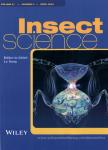Plasticity of mycangia in Xylosandrus ambrosia beetles
作者机构:School of Forest Resources and Conservation University of Florida Gainesville Florida USA School of Applied Chemistry and Biological Technology Postdoctoral Innovation Practice Base Shenzhen Polytechnic Shenzhen. Guangdong. China Florida Museum of Natural History University of Florida Gainesville Florida USA Entomology and Nematology Department University of Florida Gainesville Florida USA
出 版 物:《Insect Science》 (昆虫科学(英文版))
年 卷 期:2019年第26卷第4期
页 面:732-742页
核心收录:
学科分类:0710[理学-生物学] 0830[工学-环境科学与工程(可授工学、理学、农学学位)] 07[理学] 09[农学] 0904[农学-植物保护] 0901[农学-作物学] 0713[理学-生态学]
基 金:YL JS and JH were funded by the United States Department of Agriculture the USDA Forest Service and the National Science Foundation
主 题:callow micro-CT mycangium symbiont-induced symbiosis teneral
摘 要:Insects that depend on microbial mutualists evolved a variety of organs to transport the microsymbionts while dispersing. The ontogeny and variability of such organs is rarely studied, and the microsymbiont*s effects on the animal tissue development remain unknown in most cases. Ambrosia beetles (Coleoptera: Curculionidae: Scolytinae or Platypodinae) and their mutualistic fungi are an ideal system to study the animalfungus interactions. While the interspecific diversity of their fungus transport organ一 mycangia—is well-known, their developmental plasticity has been poorly described. To determine the ontogeny of the mycangium and the influence of the symbiotic fungus on the tissue development, we dissected by hand or scanned with micro-CT the mycangia in various developmental stages in five Xylosandrus ambrosia beetle species that possess a large, mesonotal mycangium: Xylosandrus amputatus. Xylosandrus compactus, Xylosandrus crassiusculus, Xylosandrus discolor, and Xylosandrus germanus. We processed 181 beetle samples from the United States and China. All five species displayed three stages of the mycangium development:(1) young teneral adults had an empty, deflated and cryptic mycangium without fungal mass;(2) in fully mature adults during dispersal, the promesonotal membrane was inflated, and most individuals developed a mycangium mostly filled with the symbiont, though size and symmetry varied;and (3) after successful establishment of their new galleries, most females discharged the bulk of the fun gal inoculum and deflated the mycangium. Experimental aposymbiotic individuals demonstrated that the pronotal membrane invaginated independently of the presence of the fungus, but the fungus was required for inflation. Mycangia are more dynamic than previously thought, and their morphological changes correspond to the phases of the symbiosis. Importantly, studies of the fungal symbionts or plant pathogen transmission in ambrosia beetles need to consider which developmen



